UPSC Daily Current Affairs- 16th May 2024 | Current Affairs & Hindu Analysis: Daily, Weekly & Monthly PDF Download
GS-I/Geography
Sahul
Source: Economic Times
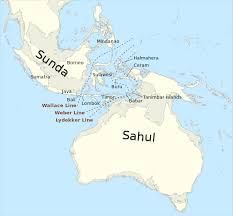
Why in News?
Recently, archaeologists have discovered evidence of a lost landmass called Sahul from ancient times, facilitating human migration across continents.
About Sahul:
- Sahul was a supercontinent that emerged during the last ice age, connecting present-day Australia to Papua New Guinea in the north and Tasmania in the south.
- It played a crucial role in enabling ancient humans to traverse from Asia to Australia approximately 7,000 years ago.
Ice Age Period:
- An ice age is a geological epoch characterized by extensive ice sheets covering large land areas, significantly altering the Earth's surface.
- The earliest known ice age occurred over 570 million years ago during the Precambrian era.
- The most recent widespread glaciations happened in the Pleistocene Epoch, ranging from 2.6 million to 11,700 years ago.
- Ice ages do not maintain a consistent level of coldness; they experience fluctuations with colder periods leading to extensive ice coverage and warmer periods resulting in reduced ice areas.
GS-I/Geography
Kanwar Lake
Source: DTE
Why in News?
Kanwar Lake, previously a haven for migratory birds, is now facing challenges to its existence.
About Kanwar Lake:
- Asia's largest freshwater oxbow lake, also known as Kabartal jheel, is a rainfed lake.
- It is a residual oxbow lake, created by the meandering of the Gandak River, a tributary of the Ganga, covering a significant portion of the Indo-Gangetic plains in northern Bihar.
- The wetland serves as a crucial stopover along the Central Asian Flyway, hosting 58 migratory waterbirds for resting and refueling. It also boasts a diverse fish population with over 50 documented species.
- Five critically endangered species are found at the site, including three vultures - the red-headed vulture, white-rumped vulture, and Indian vulture - as well as two waterbirds, the sociable lapwing and Baer's pochard.
- Threats: The main threats to Kanwar Lake include activities like water management, drainage, water abstraction, damming, and canalization.
Definition of Oxbow Lake:
- An oxbow lake is a curved body of water that forms beside a meandering river due to erosion and sediment buildup over time.
- These lakes are typically crescent-shaped and are commonly found in floodplains and low-lying areas near rivers.
GS-II/Polity and Governance
Citizenship under CAA 2019
Source: Indian Express
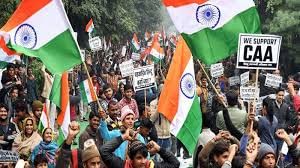
Why in News?
The Ministry of Home Affairs has issued the initial set of citizenship certificates under the Citizenship (Amendment) Act.
- The Union Home Secretary distributed citizenship certificates to the first 14 individuals in New Delhi, following their online application processing through a dedicated portal.
Key Points about Citizenship (Amendment) Act 2019
- The Act aims to modify the definition of illegal immigrants for specific religious groups from Pakistan, Afghanistan, and Bangladesh, excluding Muslims.
- It facilitates expedited Indian citizenship within 5 years for eligible individuals who had been residing in India without proper documentation.
- Additionally, the Act allows for the revocation of Overseas Citizen of India (OCI) status under certain circumstances.
Eligibility Criteria
- The CAA 2019 is applicable to those who sought refuge in India due to religious persecution, safeguarding them from illegal immigration actions.
- Applicants must have entered India on or before December 31, 2014, to qualify for citizenship consideration.
- Exceptions to the Act include regions under the Constitution's sixth schedule and states with an inner-line permit system.
Application Process
- Interested individuals must apply through the designated citizenship portal, declaring their country of origin and providing documentation linking them to Bangladesh, Pakistan, or Afghanistan.
- Applications will undergo thorough review before the issuance of citizenship certificates to eligible beneficiaries across the country.
Rules and Implementation
- The Citizenship Amendment Rules, 2024, were notified by the Ministry of Home Affairs to enable CAA enforcement.
- These regulations outline the evidence required for individuals to establish their qualifications for citizenship under the new law.
- Authorities have the discretion to set time limits for applications, with committees overseeing the citizenship approval process.
Controversies and Opposition
Public Resistance
- The Citizenship Amendment Act has encountered significant opposition in various states, especially Assam and Tripura.
- Protests in Assam were driven by concerns that the law could permanently change the state's demographic makeup.
- There are objections in Assam regarding the perceived infringement on the 1985 Assam Accord, which grants citizenship to certain migrants.
- Opposition to the Act has extended beyond the North-East, triggering nationwide demonstrations.
Legal Challenges
- Several petitions challenging the constitutional validity of the CAA, including those asserting it discriminates against Muslims, are before the Supreme Court.
- Concerns have been raised about the exclusion of certain persecuted groups from neighboring countries, prompting debates on the law's fairness and inclusivity.
GS-II/Governance
On Delhi's Mounting Waste Crisis | Explained
Source: The Hindu
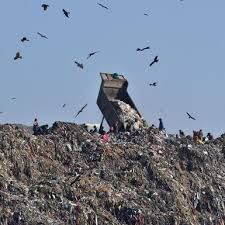
Why in News?
Recent Supreme Court remarks highlight the urgent need to address Delhi's mounting waste crisis, emphasizing a non-partisan approach.
Status of Delhi's Solid Waste Management (SWM) System
- New Delhi's population is projected to increase significantly, leading to a rise in waste generation.
- Waste composition primarily consists of Biodegradable Wet Waste, Non-Biodegradable Dry Waste, and Inert Waste.
- Majority of waste collection is managed by three municipal bodies.
- Large quantities of unprocessed waste are being disposed of in designated landfills, causing environmental hazards.
Challenges Faced by Municipal Corporation of Delhi (MCD)
- Lack of waste segregation at the source contributes to mixed waste ending up in landfills.
- Difficulty in securing land for waste processing facilities.
- Low public awareness about proper waste management practices.
- Inadequate waste collection services in certain areas.
- Instances of illegal dumping further strain waste management efforts.
Efforts Required by MCD
- Need for a decentralized approach in collaboration with neighboring states for setting up composting plants.
- Focus on processing Biodegradable Wet Waste through composting or biogas plants.
- Management of Non-Biodegradable Dry Waste, including recycling and waste-to-energy initiatives.
- Enhanced coordination among stakeholders to streamline waste collection and processing.
Conclusion
- Biomining Initiative initiated by MCD aimed at waste reduction, disrupted by the COVID-19 pandemic.
- Planned completion delayed, requiring an additional two to three years for implementation.
GS-II/Governance
Road Safety
Source: ET Insights
Why in News?
Recently, Uttar Pradesh allocated Rs 100 million to bolster road safety through the Transport Corporation.
Background: Over the years, India has been striving to address the issue of road accidents due to its large population and a growing vehicle market.
Factors Contributing to Road Accidents:
- Sporadic highway constructions and inadequate street designs lead to safety concerns.
- Lack of proper signage, road markings, and poorly constructed speed breakers add to the risks.
- Construction works along roads limit space and lead to hazards, exacerbated by inadequate traffic control.
- Environmental factors like heavy rain, fog, and hailstorms reduce visibility, increasing risks.
- Absence of sidewalks forces pedestrians onto roads, making them prone to accidents.
- Old vehicles are more susceptible to breakdowns and malfunctions, posing risks to road users.
- Violations of traffic rules, absence of safety gear, and various forms of reckless driving contribute to accidents.
- Insufficient training, testing, and lack of coordination among agencies also play a role in road safety issues.
Indian Road Safety Initiatives:
- The Motor Vehicles Amendment Act of 2019 increased penalties for violations and established a Motor Vehicle Accident Fund and National Road Safety Board.
- The Carriage by Road Act of 2007 regulates common carriers and liability related to goods transportation.
- The Control of National Highways (Land and Traffic) Act of 2000 controls land and traffic on national highways.
- The National Highways Authority of India Act of 1998 governs the development and maintenance of national highways.
Future Directions:
- Enhanced highway design for safer traffic segregation and systematic highway-street mergers.
- Regular audits to identify accident-prone zones and ensure proper warning signage.
- Mandatory safety features like crash barriers, lighting, and weatherproof roads on all routes.
- Adoption of indigenous safety technologies to reduce costs and improve accessibility.
- Implementation of Bharat NCAP for safety ratings of vehicles and a Vehicle Scrappage Policy for old vehicles.
- Increased public focus on safety awareness, stricter licensing norms, and improved driver training.
INTERACTIVE VOICE RESPONSE SYSTEM (IVRS)

Why in News?
Recently, voters have been receiving Interactive Voice Response System (IVRS) calls daily, prompting the Election Commission of India (ECI) to consider an inquiry into how telecom service providers shared mobile phone numbers with political parties.
Background:
The IVRS calls are in violation of the Telecom Regulatory Authority of India (TRAI) Act, 1997, adversely affecting numerous voters daily. The ECI's prompt intervention is crucial to safeguard voters' privacy and uphold the integrity of the electoral process.
About INTERACTIVE VOICE RESPONSE SYSTEM (IVRS):
- An Interactive Voice Response System (IVRS) stands as an automated telephony technology enabling computers to engage with individuals through voice and DTMF tones entered via a keypad.
- Commonly utilized in call centers, IVRS manages high call volumes and offers self-service options to callers.
- The advantages of employing IVRS encompass enhanced customer service, decreased wait times, and reduced operational expenses for businesses.
- Modern IVRS systems can interface with diverse networks such as public switched telephone networks (PSTN) and voice over IP (VoIP), supporting multiple applications scripted in VoiceXML.
Political Campaigns and IVRS:
- IVRS finds extensive use during elections, with political parties leveraging it to connect with voters.
- Voters receive pre-recorded messages from candidates or party leaders through IVRS, encouraging them to vote or emphasizing campaign pledges.
- These messages serve informational or persuasive purposes based on the party's campaign strategy.
GS-III/Science and Technology
Extra-pulmonary TB
Source: The Hindu
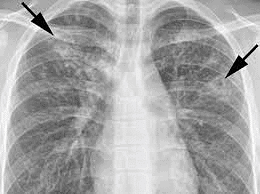
Why in News?
Nearly 20% of TB patients suffer from Extra-pulmonary TB, often undiagnosed due to the need for specialized care facilities.
Definition: Extra-pulmonary TB pertains to Tuberculosis infections impacting organs beyond the lungs like lymph nodes, brain, gut, and eyes.
Characteristics:
- Often stain negative, making it hard to detect with standard TB tests.
- Prevalent in individuals with HIV, affecting any organ and mimicking non-TB conditions.
- May manifest in any body part, sometimes without concurrent lung infection.
Challenges:
- Persistence of disease markers post-treatment resolution.
- Lack of standardized diagnosis and treatment protocols across affected organs.
- Obstacles include low awareness even among medical practitioners and imprecise diagnostic criteria.
- Some patients may still face the disease post anti-TB therapy completion.
Recommendations:
- Urgent need to update INDEX-TB guidelines, formulated over ten years ago, with contemporary data and insights.
GS-III/Environment and Ecology
International Cryosphere Climate Initiative
Source: DTE
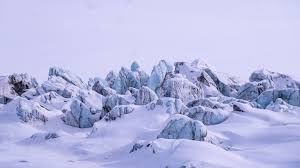
Why in News?
The International Cryosphere Climate Initiative (ICCI) highlighted that Venezuela's last glacier, the Humboldt (or La Corona) located in the Andes, has shrunk to a point where it no longer qualifies as a glacier.
About International Cryosphere Climate Initiative
- The International Cryosphere Climate Initiative (ICCI) was established in 2009 after the COP-15 conference in Copenhagen.
- It comprises a network of seasoned policy analysts and researchers collaborating with governments and institutions to formulate, influence, and execute strategies aimed at conserving as much of the Earth's cryosphere as feasible.
- The initiative concentrates on the distinctive climate mechanisms operating within the cryosphere, while concurrently intensifying global climate endeavors targeting CO2 and other greenhouse gases by underlining the swift pace and worldwide repercussions of cryosphere warming.
- Its primary focus areas encompass the Arctic, Antarctic, and elevated mountainous terrains.
Key Facts about Humboldt Glacier of Venezuela
- The Humboldt glacier, also recognized as the La Corona glacier, sits at an altitude of 4,900 meters above sea level.
- It stood as the sole remaining glacier adjacent to Venezuela's second-tallest summit, Pico Humboldt.
- Initial predictions suggested the glacier would endure for approximately another decade; however, recent evaluations reveal that the glacier has melted at a notably accelerated rate compared to expectations.
|
55 videos|5389 docs|1141 tests
|
FAQs on UPSC Daily Current Affairs- 16th May 2024 - Current Affairs & Hindu Analysis: Daily, Weekly & Monthly
| 1. What is Sahul and why is it significant? |  |
| 2. What is Kanwar Lake known for? |  |
| 3. How does the Citizenship Amendment Act (CAA) of 2019 impact Indian citizenship? |  |
| 4. How are current affairs important for the UPSC exam preparation? |  |
| 5. What are some tips for staying updated on daily current affairs for the UPSC exam? |  |





















